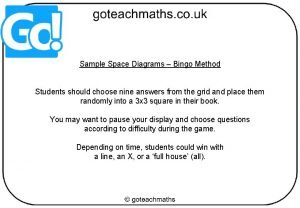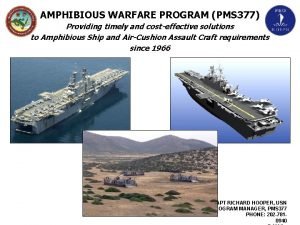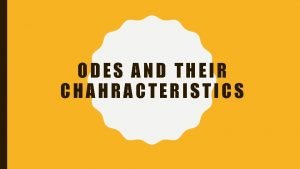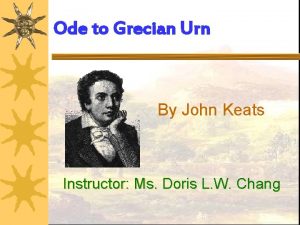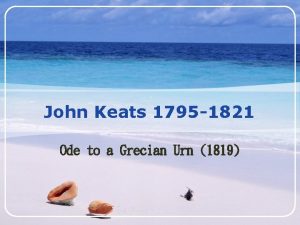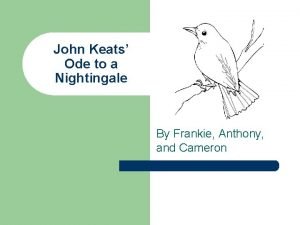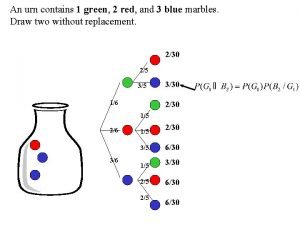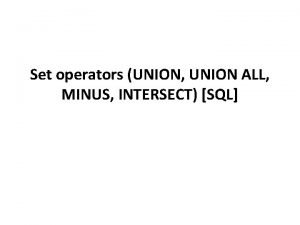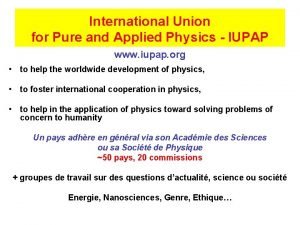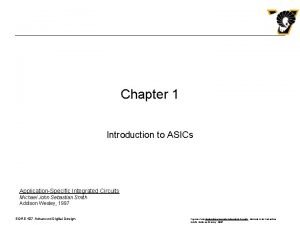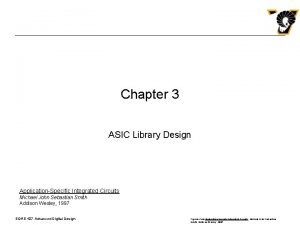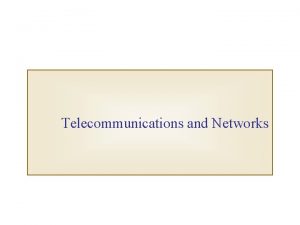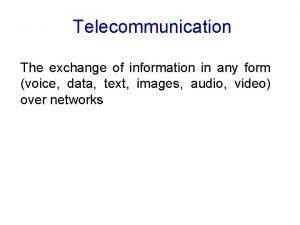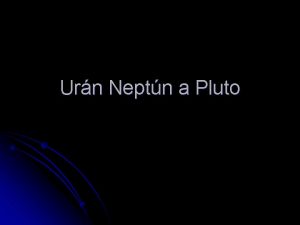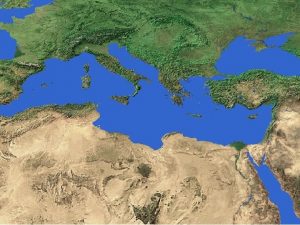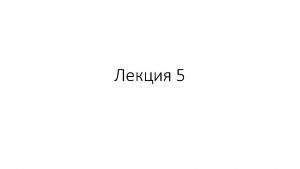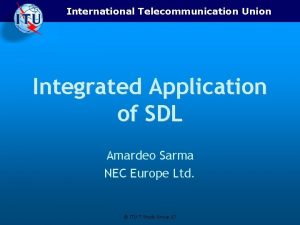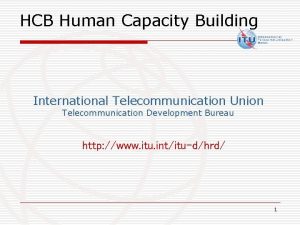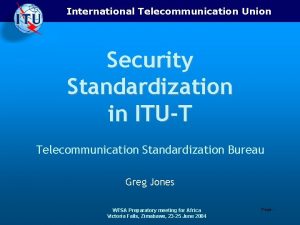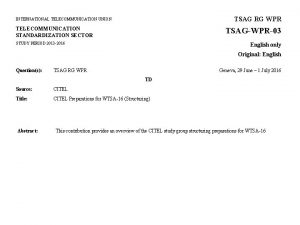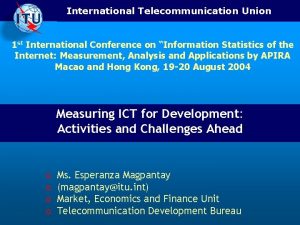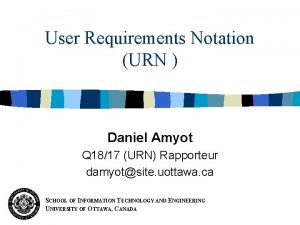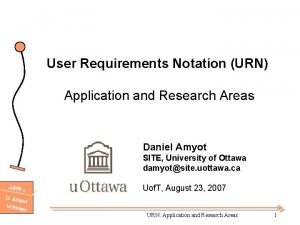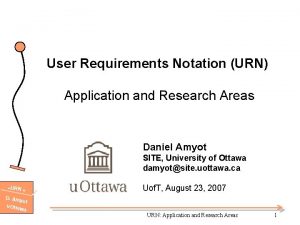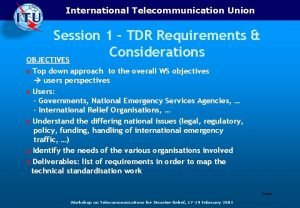International Telecommunication Union Integrated Application of URN Daniel



















- Slides: 19

International Telecommunication Union Integrated Application of URN Daniel Amyot University of Ottawa, Canada damyot@site. uottawa. ca ITU-T Workshop on the Integrated Application of Formal Languages Geneva, September 13, 2003 © ITU-T Study Group 17

URN o User Requirements Notation • Allows engineers to specify or discover requirements for a proposed system or an evolving system, and review such requirements for correctness and completeness • Helps bridging the gap between informal and formal concepts, and between requirements models and design models o URN = GRL + UCM • Combines goals and scenarios • Graphical notations • Reusable patterns o Applicable to various domains (e. g. telecom services, distributed or reactive systems), in industry and SDOs © ITU-T Study Group 17 2003

GRL (URN) o Goal-oriented Requirement Language • For incomplete, tentative, (non-functional) requirements • Capture goals, objectives, contributions, alternatives, and rationales • Supports goal analysis and qualitative evaluations © ITU-T Study Group 17 2003

UCM (URN) o Use Case Maps • Causal sequences of responsibilities, allocated to components • For operational requirements, as scenarios • Support validation, performance analysis, and evaluation of architectural alternatives © ITU-T Study Group 17 2003

Integrating GRL and UCM o Traceability between: • Goals/tasks and UCMs (or UCM scenario definitions) • Tasks and UCM responsibilities • Different granularity • Requirements management • Others… o Underspecification and overspecification • Discovery of new goals and scenarios • Removal of unnecessary goals and scenarios • Examples: • Why is a UCM scenario without any link to a GRL goal? • Why is a GRL goal without any link to a UCM scenario? o Refinements of alternative solutions • From GRL (identification) to UCM (evaluation) © ITU-T Study Group 17 2003

Example GRL Model (Wireless Service) Low Cost High Performance Less need for new hardware Impact is vendor-specific Minimum Changes to Infrastructure Maximum Hardware Utilisation Determine SDF Location SDF in SCP High Evolveability High Throughput Minimum Message Exchange Minimum Mob. SC Load SDF in SN Service in Mob. SC © ITU-T Study Group 17 2003 Service in SCP

Three Alternative Solutions (a) Service in Mob. SC (b) Service in Mob. SC, SDF in SN (c) Service and SDF in SCP © ITU-T Study Group 17 2003

Integrating UCM and MSC o Automated transformation from UCM to MSC • Traversal of UCMs based on Scenario Definitions • Enables scenario highlight on UCMs • Paths visited can be transformed to MSCs • Enables the generation of more detailed design scenarios © ITU-T Study Group 17 2003

UCMNav and Scenario Definitions © ITU-T Study Group 17 2003

Two Resulting MSCs © ITU-T Study Group 17 2003

Integrating UCM and SDL o Generating MSC enables the synthesis of SDL specifications • Early prototyping and requirements analysis • Some results already available • Presented at the 11 th SDL Forum, 2003 UCM Exporter MSC 2 SDL © ITU-T Study Group 17 2003 SDL

Integrating UCM and UML o Similar transformations from UCM to: • UML sequence diagrams • UML activity diagrams o These can be used to further synthesize state diagrams © ITU-T Study Group 17 2003

Integrating UCM and TTCN-3 o UCM scenarios can be used as test goals • Structured UCM scenarios converted to test suite • Coverage of operational requirements • Another transformation: TTCN-3 © ITU-T Study Group 17 2003

UCMNav and UCMExporter o UCMNav 2 generates scenarios (in XML) from traversals • http: //www. Use. Case. Maps. org/tools/uvmnav o UCMExporter takes these as input and generates: • MSC (Z. 120, textual form) • UML sequence diagrams (in XMI) • TTCN-3 o http: //ucmexporter. sourceforge. net/ © ITU-T Study Group 17 2003

Integrating UCM and LQN o Quantitative performance analysis with Layered Queuing Networks o Transformation from complete UCM model to an LQN model • Supported by UCMNav o Enables: • Analytic evaluations (LQNS) • Simulations (LQSim) o http: //www. Layered. Queuing. org © ITU-T Study Group 17 2003

UCMs and Performance Arrival Characteristics • Exponential, or • Deterministic, or • Uniform, or • Erlang, or • Other Population size Timestamp Tax. Payer Device Characteristics • Processors, disks, DSP, external services… • Speed factors Security T 1 Access E_Accountant T 2 Check. Bio Continue Ready Rejected Components • Allocated responsibilities • Processor assignment Can generate Layered Queuing Networks (LQN) automatically! OR Forks • Relative weights (probability) Response Time Requirement • From T 1 to T 2 • Name • Response time • Percentage Responsibilities • Data access modes • Device demand parameters • Mean CPU load (time) • Mean operations on other devices © ITU-T Study Group 17 2003

From Goals to Design, Performance, and Test Artifacts o Initial traceability from GRL goals to UCMs leads (transitively) to traceability between goals and: • Design scenarios (MSC, UML SD) • Internal behaviour (SDL) • Test (TTCN-3) • Performance evalutions (LQN) © ITU-T Study Group 17 2003

Still To Be Explored… o Integrated use of URN and • e. ODL • object interfaces • Deployments • ASN. 1 • Interface/message definitions • Other requirements • URN can’t express everything… © ITU-T Study Group 17 2003

For More Information… o User Requirements Notation • URN Focus Group • http: //www. Use. Case. Maps. org/urn/ o Papers • UCM Virtual Library • http: //www. Use. Case. Maps. org/pub/ © ITU-T Study Group 17 2003
 International arrival urn
International arrival urn Drawing a bingo tablet from a bingo urn sample space
Drawing a bingo tablet from a bingo urn sample space Urn shaped age pyramid
Urn shaped age pyramid Pms377
Pms377 Whats and ode
Whats and ode Byron shelley and keats mastery test
Byron shelley and keats mastery test Ode on a grecian urn paraphrase
Ode on a grecian urn paraphrase Ode on a grecian urn summary
Ode on a grecian urn summary Synesthesia literary device
Synesthesia literary device Urn a contains 2 red and 3 blue marbles
Urn a contains 2 red and 3 blue marbles Union union all intersect
Union union all intersect International union of forest research organizations
International union of forest research organizations International union of pure and applied physics
International union of pure and applied physics Gate array based asic
Gate array based asic Asic library
Asic library Telecommunications project management
Telecommunications project management Objectives of telecommunication
Objectives of telecommunication Telecommunication information
Telecommunication information Telecommunications and data communications
Telecommunications and data communications What is telecommunication network
What is telecommunication network

